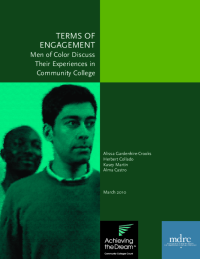Terms of Engagement
Men of Color Discuss Their Experiences in Community College
Community colleges provide access to higher education for millions of Americans who might not otherwise be able to pursue it. However, despite the pivotal role these institutions play in promoting social equity, they continue to struggle with low student persistence and completion rates, particularly among male students of color. It is this dilemma that spurred Lumina Foundation to launch the Achieving the Dream initiative in 2003 as a bold national effort to improve student outcomes and reduce achievement gaps at community colleges.
This study draws on the experiences of 87 African-American, Hispanic, and Native American men who were enrolled in developmental math courses at four Achieving the Dream institutions to find out more about what affects the success of men of color in community college. The fieldwork explored how students’ experiences in their high schools and communities, as well as their identities as men of color, influenced their decisions to go to college and their engagement in school. The students offered their perspectives in their own words in three rounds of focus groups and interviews during the 2007-08 academic year. Key findings include:
- Motivations for going to college. There was no “average upbringing” among the men in this sample; their family situations and economic backgrounds were diverse, and the time that had elapsed between high school and college ranged from one year to 10 or more. Nevertheless, the men shared common motivations for enrolling in college. Those most frequently cited were to increase their earning power and to be a role model for their children.
- Encounters with prejudice. These men identified low expectations and negative stereotypes based on their race, ethnicity, and gender as salient elements of their experiences in their high schools, communities, and sometimes on their college campuses. While the nature and intensity of these experiences varied across racial and ethnic groups, men in all groups recounted that they had been unfairly judged by their appearance.
- Identities as men of color. Though most of the men initially found their community college to be more welcoming than their high school, they reported negative encounters over time with some faculty and staff. The men explicitly rejected stereotypes based on their race or ethnicity and said that such attitudes did not affect their self-image or behavior. By contrast, norms related to their identity as men — characterized principally by self-reliance — exerted a powerful influence on their ability to engage in college. Whether placing a priority on paid work over school, avoiding making friends on campus, or failing to seek out academic or financial help, these men frequently acted in ways that reinforced their masculine identities, while at times hindering their chances of academic success.
By reporting how these men perceive their college environment and its challenges, this study hopes to take an important step toward understanding what community colleges can do to better meet the needs of their male students of color. The report concludes with some recommendations for how community colleges can ensure that these students receive the benefits of supports that can help them succeed and outlines a number of strategies that have already shown promise in improving the outcomes of underprepared community college students.






